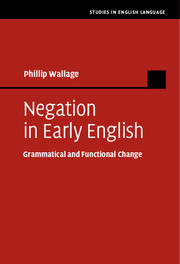Book contents
- Frontmatter
- Dedication
- Contents
- List of figures
- List of tables
- Acknowledgements
- Abbreviations
- 1 Introduction
- 2 Quantitative Evidence for a Model of the Jespersen Cycle in Middle English
- 3 Distributional Evidence for Two Types of ne: Redundant Negation
- 4 Distributional Evidence for Different Types of not
- 5 The Syntax of the Early English Jespersen Cycle: A Morphosyntactic Feature-based Account
- 6 The Role of Functional Change in the Jespersen Cycle
- 7 Negative Concord in Early English
- 8 Negative Inversion: Evidence for a Quantifier Cycle in Early English
- 9 The Loss of Negative Concord: Interaction Between the Quantifier Cycle and the Jespersen Cycle
- 10 Conclusion
- References
- Index of names
- Index of subjects
2 - Quantitative Evidence for a Model of the Jespersen Cycle in Middle English
Published online by Cambridge University Press: 13 July 2017
- Frontmatter
- Dedication
- Contents
- List of figures
- List of tables
- Acknowledgements
- Abbreviations
- 1 Introduction
- 2 Quantitative Evidence for a Model of the Jespersen Cycle in Middle English
- 3 Distributional Evidence for Two Types of ne: Redundant Negation
- 4 Distributional Evidence for Different Types of not
- 5 The Syntax of the Early English Jespersen Cycle: A Morphosyntactic Feature-based Account
- 6 The Role of Functional Change in the Jespersen Cycle
- 7 Negative Concord in Early English
- 8 Negative Inversion: Evidence for a Quantifier Cycle in Early English
- 9 The Loss of Negative Concord: Interaction Between the Quantifier Cycle and the Jespersen Cycle
- 10 Conclusion
- References
- Index of names
- Index of subjects
Summary
Introduction
This chapter discusses different syntactic approaches to the Jespersen Cycle. These syntactic analyses structure the cycle differently, postulating different pathways of diachronic change that make different predictions about the distribution of negative markers during the Middle English period. These predictions form the basis for quantitative models of the Jespersen Cycle that are tested for goodness of fit against the actual distribution of negative markers in the PPCME2 corpus (Kroch andTaylor, 2000). The results indicate that only one of these syntactic approaches can model the distribution of negative markers in diachronic corpus data in a way that both captures the observed distributions of ne, ne…not and not, and is consistent with the principles of morphosyntactic competition outlined by Kroch (1989).
Analyses of the Jespersen Cycle which assume a generative approach to syntactic theory fall into two broad groups with respect to how they structure the Jespersen Cycle. One group, including Haegeman (1995), Frisch (1997), Roberts and Roussou (2003) and Zeijlstra (2004), hypothesise that the early stages of the Jespersen Cycle represent only a change in the forms associated with particular syntactic positions. At both stage one (ne) and stage two (ne… not), they assume the same underlying syntactic structures and configurations – aNegP, in which there is agreement between a specifier (spec, NegP) and a head (Neg0). At stage one, spec, NegP hosts a null negative operator. At stage two, the negative operator is overt, lexically realised by not. Thus the transition from ne to ne… not is a change in the way the spec, NegP position is realised – a change in the form of the negative operator.
The development of the negative operator not proceeds through grammaticalisation of a negative adverb. The etymological origin of not is Old English nawiht ‘no creature’. It undergoes a category shift from nominal to adverbial and comes to be used as a minimiser in certain pragmatic contexts (see Chapter 4 for a more detailed history of not). Thus accounts of the Jespersen Cycle such as Frisch (1997) postulate an intermediate stage in the development of bipartite forms, in which not is not a negative operator but a negative adverb or minimiser. The syntactic configurations involved are given in (9).
- Type
- Chapter
- Information
- Negation in Early EnglishGrammatical and Functional Change, pp. 11 - 37Publisher: Cambridge University PressPrint publication year: 2017

